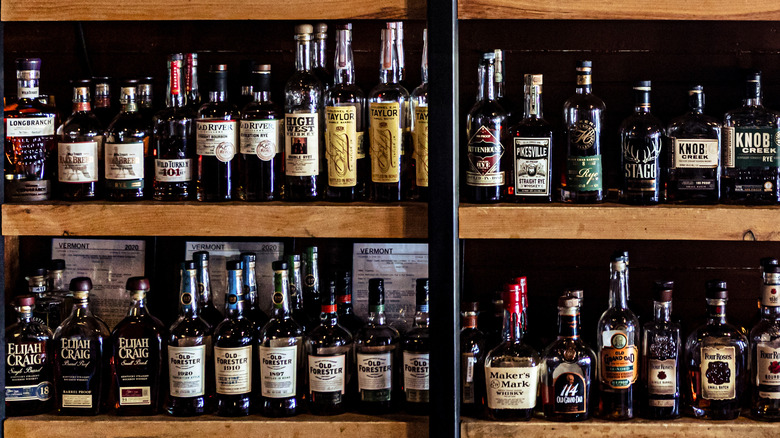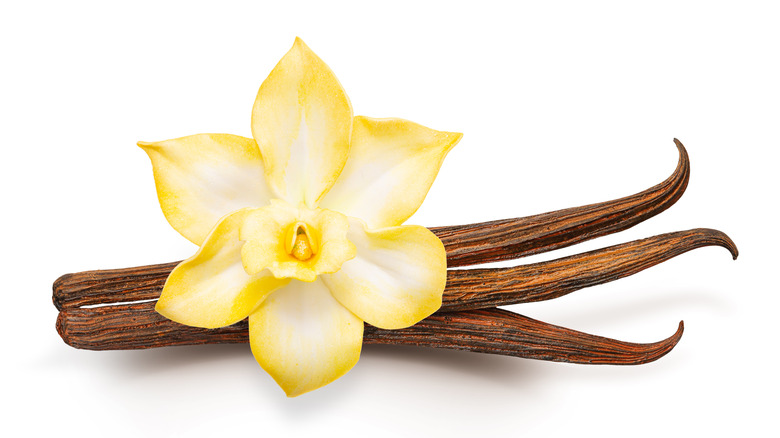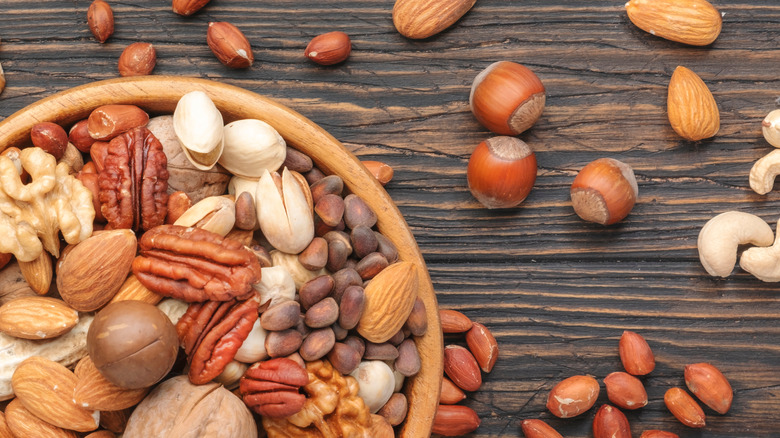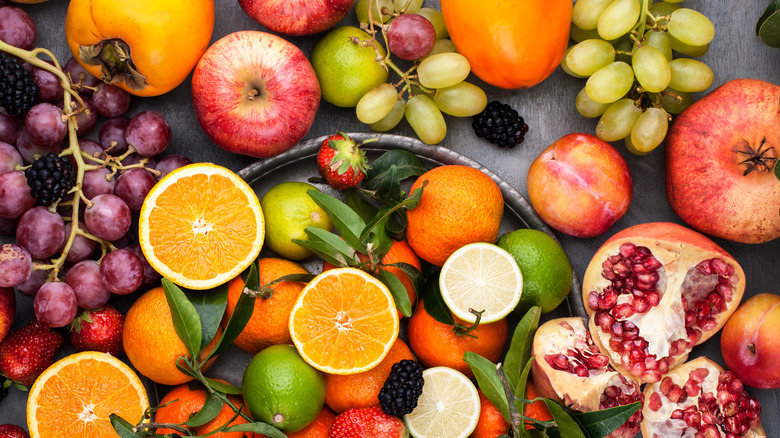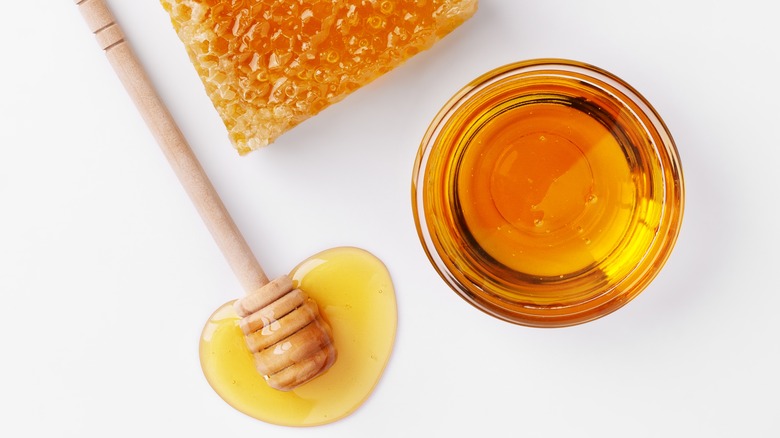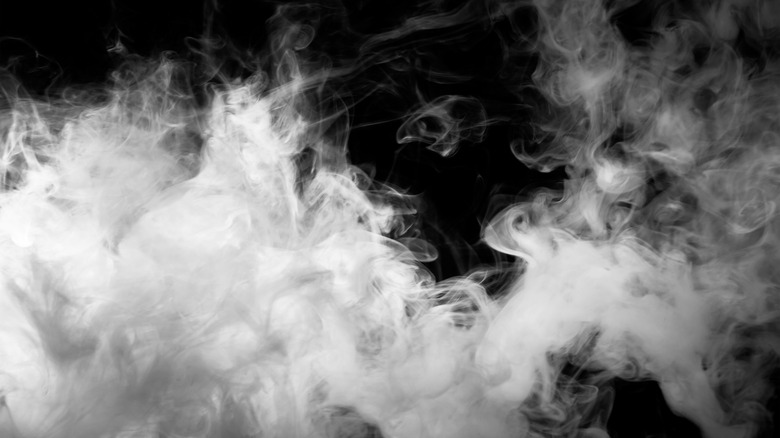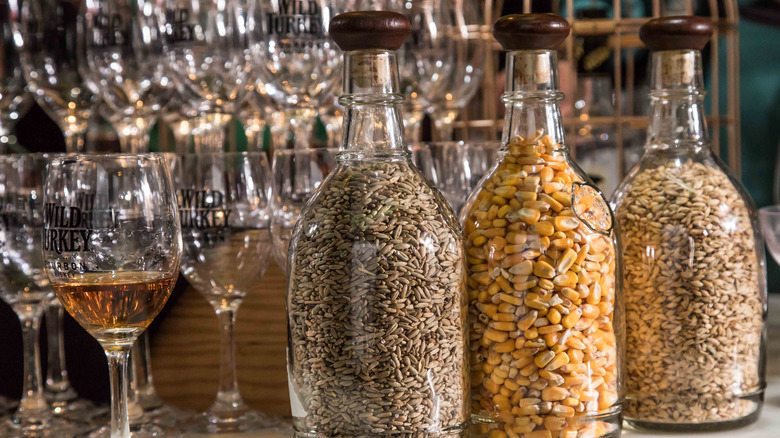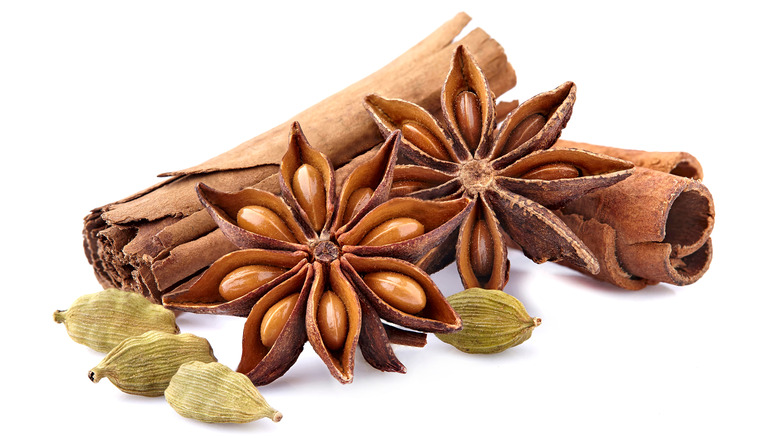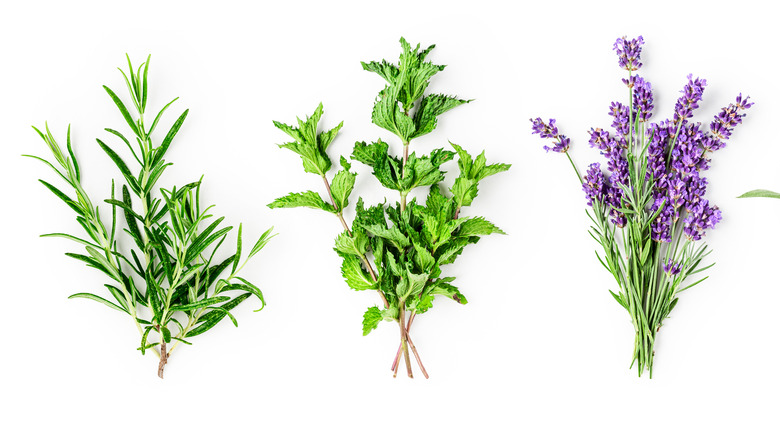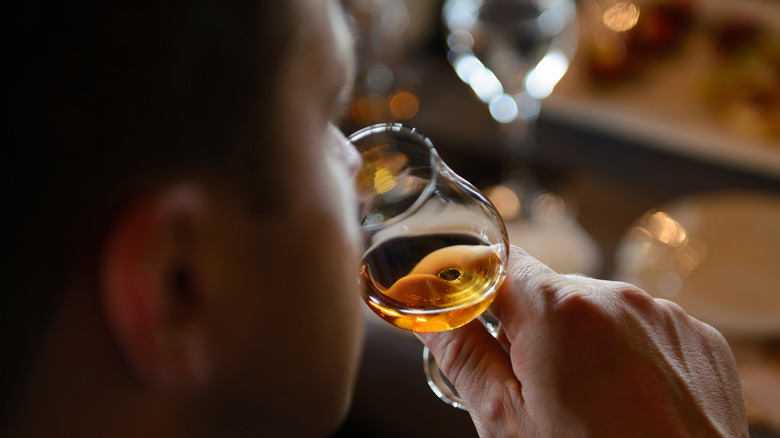9 Of The Most Common Tasting Notes For Bourbon
Professional tasters claim to find a nearly infinite range of tasting notes in bourbon, from Milky Way bars to wet leather, limited only by a taster's experiences, imagination, and vocabulary. But bourbon-tasting notes don't need to be complicated or require a thesaurus.
Tasting bourbon involves the nose, flavor, and finish of bourbon on the palate, according to Jackson Strayer-Benton, an Executive Bourbon Steward of the Stave and Thief Society. As Beverage Director of Heirloom Hospitality, Strayer-Benton also oversees the beverage managers at Prohibition Pig, Hen of the Wood, and Doc Ponds in Vermont.
The tasting notes in bourbon come from several sources, including the strain of yeast used in distilling and the grains used in the mash bill. The largest portion of flavor — 60 percent — comes from aging in a new charred oak barrel, along with all the color of bourbon, according to Heaven Hill Distillery.
To adjust your palate, take a sniff, swirl it in your mouth for a few seconds, swallow, exhale out your mouth, and then breathe in through your nose before exhaling again, recommends Watershed Distillery. Choosing a glass that concentrates aroma can also be helpful, as most tasting notes come from the aroma of bourbon, according to Strayer-Benton. He prefers a Glencairn glass for bourbon tastings and diluting it with a few drops of water to reduce the heat. Pairing food with bourbon is another way to pick out specific tasting notes. From beginners to experts, these are the nine common tasting notes everyone can appreciate.
Vanilla
Vanilla is one of the most common tasting notes drinkers notice when smelling and drinking bourbon. According to Strayer-Benton, vanilla notes originate in the barrel aging of bourbon. Lignin, a compound found in the cell walls of wood, is a source of vanillin, which is used in making artificial vanilla flavoring, according to Angel's Envy. While the American white oak barrels used to age bourbon actually contain less vanillin than European oak, the charring of the interior of the barrels creates guaiacol, a molecule formed by the burning of lignin, which is responsible for the flavor we perceive as vanilla.
While bourbon must be aged at least two years to be considered mature, with four years in the barrel as a more standard amount of time, vanillin rises to a noticeable level after aging for just six months in a toasted American oak barrel, according to Douglas Laing.
This tasting note can be enhanced by diluting bourbon with water. When water is introduced, it causes guaiacol to concentrate at the surface of the drink, making it easier to smell and improving the bourbon's flavor. A vanilla-forward bourbon that Strayer-Benton recommends is Wild Turkey Rare Breed Barrel Proof Bourbon. He suggests smelling the glass after finishing your drink to further appreciate the aroma.
Wood and nuts
Woody and nutty-tasting notes can range from oak and cedar to almond, hazelnut, pecan, walnut, and coconut. Nutty flavors can be created by components of the mash bill, with both malted barley and rye creating nutty-tasting notes within bourbon.
If you taste a specific nut rather than a general nutty note, you're not wrong. Specific compounds in bourbon can contribute to these individual tasting notes. The organic compound aldehyde furfural, created during the malting and distillation steps, lends a marzipan or almond-tasting note to bourbon, per CompoundChem. Some of the woody aromas in bourbon are due to lactones within the oak barrel, which we perceive as both woody and coconut flavors.
Having nuts on hand while tasting bourbon can help you distinguish between walnuts and a different nut, like almond or pecan. Two bourbons Strayer-Benton suggests for tasters interested in woody and nutty tasting notes are Wild Turkey Rare Breed, which is a barrel-proof bourbon, and Old Forester 1910 Old Fine Whisky, which has strong oak notes due to a second barreling during the aging process.
Fruit
Fruity notes in bourbon offer a welcome balance against spicy, nutty, smoky, and woody-tasting notes. They can range from more humble fruits like apples, pears, berries, stone fruit, and citrus to more exotic fruits like figs, pineapples, mango, and papaya.
These tasting notes originate in the esters created in bourbon throughout the entire process, from fermentation to barrel aging. Different esters lead to varying fruity notes: ethyl hexanoate creates sweet apple notes, and isoamyl acetate is perceived as banana-like, per CompoundChem. Acetic acid esters create pear notes and lactic acid esters, which originate in malted grains (like malted barley) in the mash bill, are creamy and fruity, per Rabbit Hole Spirits.
The mash bill can also influence how fruity a bourbon is; a rye-heavy bourbon will likely have desirable dried and dark fruit notes. Rebel Bourbon explains that both rye and corn can contribute ripe and dried fruit flavors, while wheat content creates dried berry notes.
Pairing bourbon with similar foods like jams and fresh or dried fruits can help you pick out these notes in bourbon. A fruit-forward bourbon Strayer-Benton recommends is Barrell Bourbon Batch 031.
Sweets
Sweet-tasting notes in bourbon can range from lighter flavors like brown sugar, butterscotch, caramel, honey, and maple syrup to more intense notes of chocolate, molasses, and toffee. Bourbon drinkers looking for these notes should look for a mash bill with a higher proportion of corn, which Strayer-Benton says offers a sweeter bourbon. Wheated bourbons also tend to be softer and sweeter, so a wheated bourbon like Maker's Mark, which is made using soft red winter wheat, will have more sweet-tasting notes at the front of the palate.
Caramelized wood sugars in the oak barrel also lend some of these notes. Both furfural and cyclotene create caramel flavors, with cyclotene also offering notes of maple syrup, according to the American Institute of Chemical Engineers.
Pairing a bourbon with caramel or chocolate can help you pick out the sweet notes in the glass, or a contrasting savory food like aged cheese can also act as a foil to these sugary-tasting notes. A bourbon featuring malty, chocolate-tasting notes Strayer-Benton recommends is Old Forester 1920 Prohibition Style. Two other sweet-forward bourbons recommended by the American Bourbon Association include Weller 12 and Pappy Van Winkle.
Smoke
Smoke is a tasting note in bourbon created by the charring of the American oak barrels. Like vanilla-tasting notes, smoke or even peppery notes are due in part to the molecule guaiacol, which can be enhanced by diluting a bourbon with a small amount of water.
Whether you enjoy a smoky bourbon may be due partly to your genes. According to Whisky Advocate, variations in the gene OR10G4 determine how well you can detect guaiacol, which influences whether you enjoy this tasting note or not, in addition to formative experiences involving the smell of smoke during childhood.
Other compounds that create a smoky aroma or taste in bourbon include syringol, as well as 4-ethylguiacol, which creates a bacon-like aroma, and cresol, which leads to a tar aroma, according to Tales of the Cocktail Foundation.
Malted barley is another source of smoky-tasting notes. In fact, those smoky, earthy notes are why scotch distilleries use a large portion of barley in their mash bills, according to Rabbit Hole Distillery. According to Lux Row Distillers, a gently smoky bourbon to try is David Nicholson 1843. Pairing a smoky bourbon with smoked meats, bacon, or roasted nuts may help you better taste these notes in the glass.
Grain and cereal
Many grain and cereal-tasting notes in bourbon are created by the actual grains used in the mash bill, which can include corn, rye, wheat, and malted barley. According to Strayer-Benton, their proportions in the mash create different flavor profiles.
One of the requirements to be legally considered a straight Kentucky bourbon is that the mash bill must be at least 51% corn, so all bourbon will have a sweetness and potentially related notes of corn, like hot cereal or cornbread.
While wheat is not a required grain in the mash bill of bourbon, wheated bourbons can carry a range of cereal, cracker, or bready notes, according to Distiller. Malted barley is another grain that lends cereal-like and malty flavors and aromas to bourbon. Rye is another grain in some but not all bourbons and can remind tasters of a loaf of rye bread in their tasting notes. Woodford Reserve Straight Bourbon Whiskey is a bourbon with "bold grain" notes, according to the Woodford Reserve site.
Baking spices
Baking spices are commonly reported tasting notes in bourbon. Their gentle kick can balance sweetness and accent woody and smoky notes, creating a more complex and layered sip. Some of the many baking spice notes tasters find in bourbon include cinnamon, nutmeg, clove, black pepper, allspice, and cardamom.
Rye-heavy bourbons are well known for having more peppery, spice-laden tasting notes. The oak barrel itself also contributes baking spice notes to bourbon as it ages, according to Heaven Hill Distillery. As explained by Whisky Magazine, aldehydes originating in the oak wood contribute several compounds that create baking spice tasting notes, including eugenol, which is related to nutmeg and clove, and the cinnamon-flavored cinnamaldehyde.
A bourbon Strayer-Benton recommends with heavier baking spice tasting notes is Wild Turkey Rare Breed Barrel Proof Bourbon. According to the American Bourbon Association, three spice-forward bourbons are Blanton's, Hancock Reserve, and Knob Creek Kentucky Straight Rye.
Herbal and floral
A more delicate category of tasting notes in bourbon are herbal and floral notes, which can include mint, jasmine, lavender, rose petals, green tea, and rosemary. In fact, bourbon contains terpenes (plant-derived volatiles) like linalool (found in lavender, basil, and coriander), geraniol, camphor, and limonene, which creates citrus notes, via The Whiskey Wash.
According to the American Bourbon Association, yeast can create floral and herbal notes during fermentation. Four Roses Bourbon lays out their mash bills and how the five types of yeast they use can drastically change tasting notes, showing that their "yeast Q" creates floral aromas. In contrast, "yeast F" lends herbal notes, despite two very different mash bills, underscoring the power yeast has in creating these tasting notes.
For an herbal and minty bourbon, try Four Roses Small Batch Select, and for a floral bourbon with notes of rose, honeysuckle, and lavender, try their flagship Four Roses Bourbon.
Mouthfeel
The mouthfeel of bourbon is a combination of the weight and viscosity of the liquor on your tongue, as well as the finish on your palate, explains Strayer-Benton. He suggests paying attention to whether it feels smooth or harsh and if it fades quickly or lingers.
Lux Row Distillers explains that bourbon is usually between 80 and 100 proof, while barrel-proof bourbons cannot exceed 125 proof. A higher-proof bourbon will have a drying, "hot" feel on the palate as the liquor contains a higher proportion of alcohol to water than a lower-proof bottle would.
Another contributor to different mouthfeel-related tasting notes is tannins, plant-based polyphenols that generate a bitter, astringent, and drying sensation on the palate. Tannins are found in plants, including walnuts, tea leaves, red grapes, and cacao, according to Wine Enthusiast. That's why you'll find the same palate-drying sensation in a strong cup of tea, an oaky glass of cabernet wine, and in more tannic bourbons.
Tannins are extracted from the charred oak barrel by the alcohol in the distillate during the barrel aging process, according to Strayer-Benton. Tannins rapidly enter the bourbon during the first year of aging, per the American Institute of Chemical Engineers.
Bourbon with a "big, bold, rich, thick mouthfeel," according to Strayer-Benton, is Old Forester 1920 Prohibition Style, which has a higher alcohol content at a proof of 115.
